Assessment 2: Poor Nursing Practice Analysis and Discussion
VerifiedAdded on 2023/03/17
|6
|1448
|67
Homework Assignment
AI Summary
This assignment analyzes a video depicting a student nurse's interaction with a patient, identifying and discussing four key errors related to therapeutic communication and professional boundaries. The student's actions are evaluated based on their impact on patient safety and the establishment of a therapeutic relationship. The analysis highlights violations such as disregarding the patient's needs, violating professional boundaries through inappropriate personal disclosures, demonstrating incompetence, and ignoring boundary-blurring areas. Each error's significance is discussed, along with the correct actions the student should have taken to ensure effective communication, maintain professionalism, and prioritize patient well-being. The paper emphasizes the importance of maintaining focus, demonstrating competence, and adhering to ethical guidelines in nursing practice to foster trust, promote patient comfort, and facilitate recovery. The assignment underscores the critical role of therapeutic communication in healthcare and its direct link to patient outcomes.
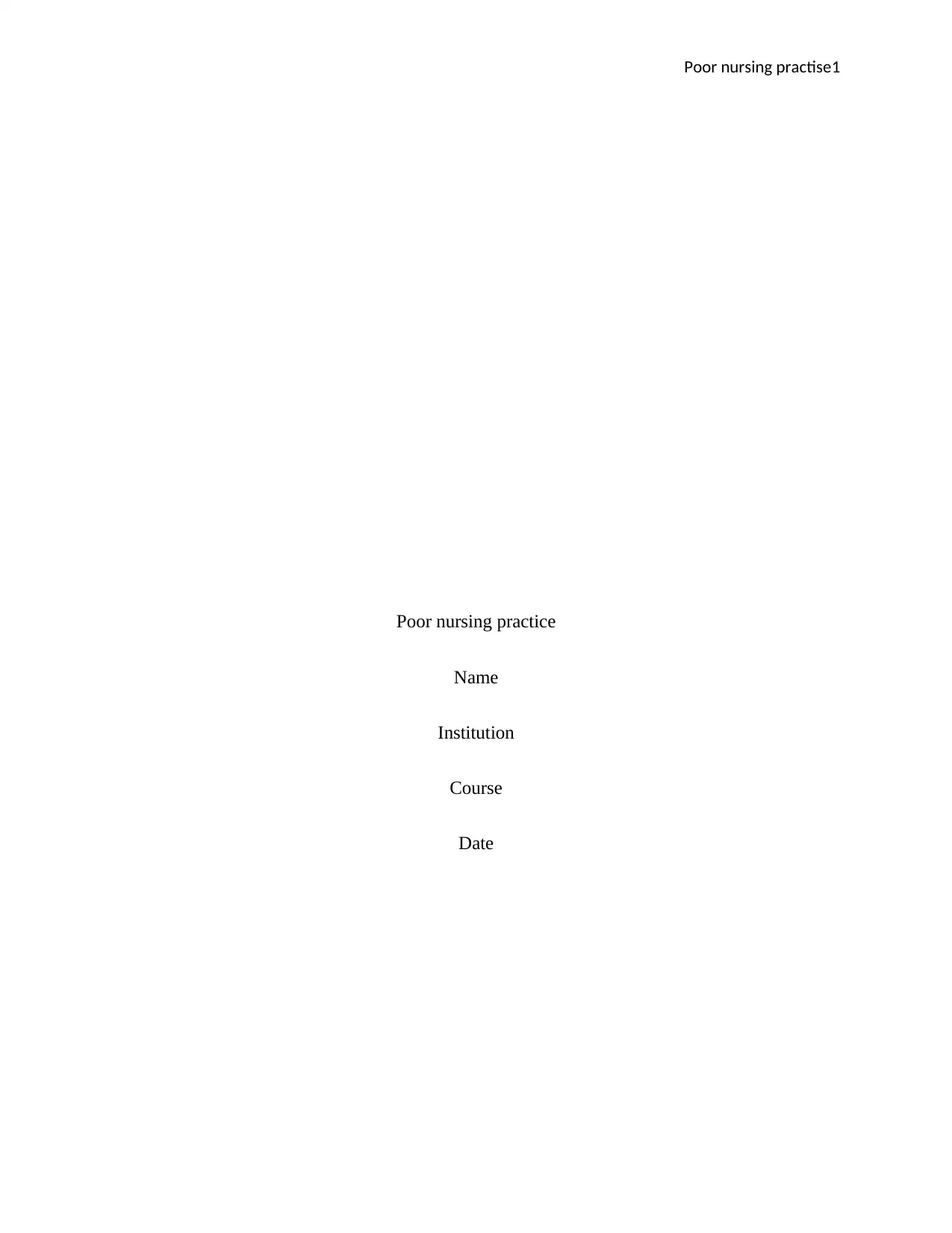
Poor nursing practise1
Poor nursing practice
Name
Institution
Course
Date
Poor nursing practice
Name
Institution
Course
Date
Paraphrase This Document
Need a fresh take? Get an instant paraphrase of this document with our AI Paraphraser

Poor nursing practise2
Poor nursing practice
Therapeutic communication is defined as the conversation and interaction between a
nurse and a patient that is aimed at the physical and emotional healing of the patient. Nurses are
expected to maintain a professional relationship with their patients which should be aimed at
attaining the patient’s healthcare expectations. Professional boundaries guide the nurses on the
appropriate behaviour when dealing with the patients. Professional boundary violation refers to
the behaviour of a nurse that is not aimed at providing therapeutic care to patients (Riley, 2015).
Violation of professional boundary
In the video, the first error that the student makes is to violate the professional boundary
that exists between a nurse and a patient. The focus of the nurse should be on the patient. When
the nurse enters the room, she is more concerned about her looks other than the well-being of the
patient. She starts by making her hair which is selfish and unprofessional. Just at the patient
notes, it is unclean and rude to be concerned about your looks before a patient suffering in pain
(Niezen et al 2014).
During the interaction with the patient, the student is distracted by an incoming message
on her phone. She removes the phone and starts reading the message in total negligence of the
patient. The student then goes ahead to discuss her matters with the patient who is inconsiderate
and cruel bearing in mind the patient was in for endometriosis which is a painful condition and
was not interested in the personal life of the nurse. Interaction between a nurse and a patient
should be focused on getting the patient better. Maintaining a therapeutic relationship ensures
that the interaction of the nurse and the patient is helpful to the recovery of the patient. Over-
Poor nursing practice
Therapeutic communication is defined as the conversation and interaction between a
nurse and a patient that is aimed at the physical and emotional healing of the patient. Nurses are
expected to maintain a professional relationship with their patients which should be aimed at
attaining the patient’s healthcare expectations. Professional boundaries guide the nurses on the
appropriate behaviour when dealing with the patients. Professional boundary violation refers to
the behaviour of a nurse that is not aimed at providing therapeutic care to patients (Riley, 2015).
Violation of professional boundary
In the video, the first error that the student makes is to violate the professional boundary
that exists between a nurse and a patient. The focus of the nurse should be on the patient. When
the nurse enters the room, she is more concerned about her looks other than the well-being of the
patient. She starts by making her hair which is selfish and unprofessional. Just at the patient
notes, it is unclean and rude to be concerned about your looks before a patient suffering in pain
(Niezen et al 2014).
During the interaction with the patient, the student is distracted by an incoming message
on her phone. She removes the phone and starts reading the message in total negligence of the
patient. The student then goes ahead to discuss her matters with the patient who is inconsiderate
and cruel bearing in mind the patient was in for endometriosis which is a painful condition and
was not interested in the personal life of the nurse. Interaction between a nurse and a patient
should be focused on getting the patient better. Maintaining a therapeutic relationship ensures
that the interaction of the nurse and the patient is helpful to the recovery of the patient. Over-
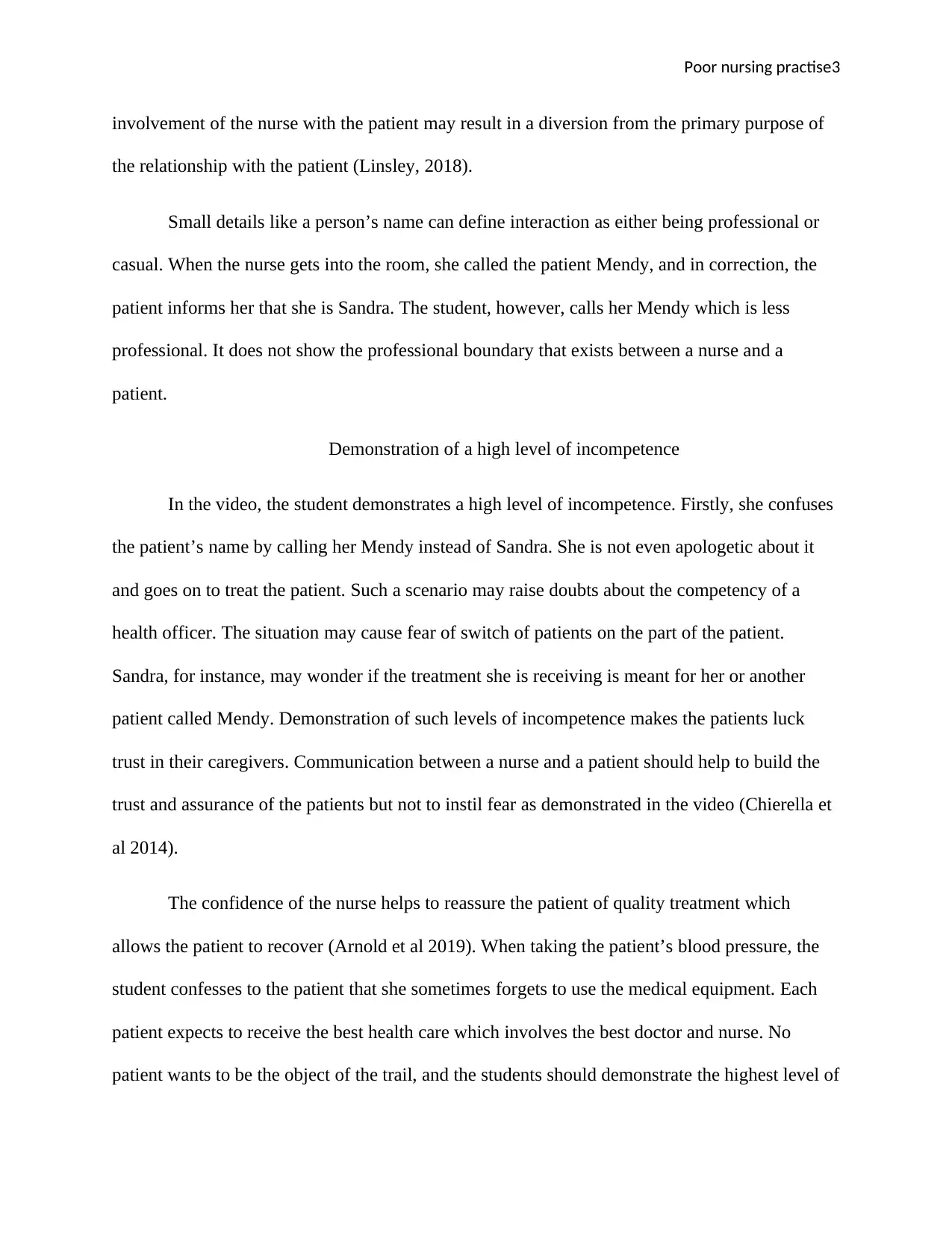
Poor nursing practise3
involvement of the nurse with the patient may result in a diversion from the primary purpose of
the relationship with the patient (Linsley, 2018).
Small details like a person’s name can define interaction as either being professional or
casual. When the nurse gets into the room, she called the patient Mendy, and in correction, the
patient informs her that she is Sandra. The student, however, calls her Mendy which is less
professional. It does not show the professional boundary that exists between a nurse and a
patient.
Demonstration of a high level of incompetence
In the video, the student demonstrates a high level of incompetence. Firstly, she confuses
the patient’s name by calling her Mendy instead of Sandra. She is not even apologetic about it
and goes on to treat the patient. Such a scenario may raise doubts about the competency of a
health officer. The situation may cause fear of switch of patients on the part of the patient.
Sandra, for instance, may wonder if the treatment she is receiving is meant for her or another
patient called Mendy. Demonstration of such levels of incompetence makes the patients luck
trust in their caregivers. Communication between a nurse and a patient should help to build the
trust and assurance of the patients but not to instil fear as demonstrated in the video (Chierella et
al 2014).
The confidence of the nurse helps to reassure the patient of quality treatment which
allows the patient to recover (Arnold et al 2019). When taking the patient’s blood pressure, the
student confesses to the patient that she sometimes forgets to use the medical equipment. Each
patient expects to receive the best health care which involves the best doctor and nurse. No
patient wants to be the object of the trail, and the students should demonstrate the highest level of
involvement of the nurse with the patient may result in a diversion from the primary purpose of
the relationship with the patient (Linsley, 2018).
Small details like a person’s name can define interaction as either being professional or
casual. When the nurse gets into the room, she called the patient Mendy, and in correction, the
patient informs her that she is Sandra. The student, however, calls her Mendy which is less
professional. It does not show the professional boundary that exists between a nurse and a
patient.
Demonstration of a high level of incompetence
In the video, the student demonstrates a high level of incompetence. Firstly, she confuses
the patient’s name by calling her Mendy instead of Sandra. She is not even apologetic about it
and goes on to treat the patient. Such a scenario may raise doubts about the competency of a
health officer. The situation may cause fear of switch of patients on the part of the patient.
Sandra, for instance, may wonder if the treatment she is receiving is meant for her or another
patient called Mendy. Demonstration of such levels of incompetence makes the patients luck
trust in their caregivers. Communication between a nurse and a patient should help to build the
trust and assurance of the patients but not to instil fear as demonstrated in the video (Chierella et
al 2014).
The confidence of the nurse helps to reassure the patient of quality treatment which
allows the patient to recover (Arnold et al 2019). When taking the patient’s blood pressure, the
student confesses to the patient that she sometimes forgets to use the medical equipment. Each
patient expects to receive the best health care which involves the best doctor and nurse. No
patient wants to be the object of the trail, and the students should demonstrate the highest level of
⊘ This is a preview!⊘
Do you want full access?
Subscribe today to unlock all pages.

Trusted by 1+ million students worldwide
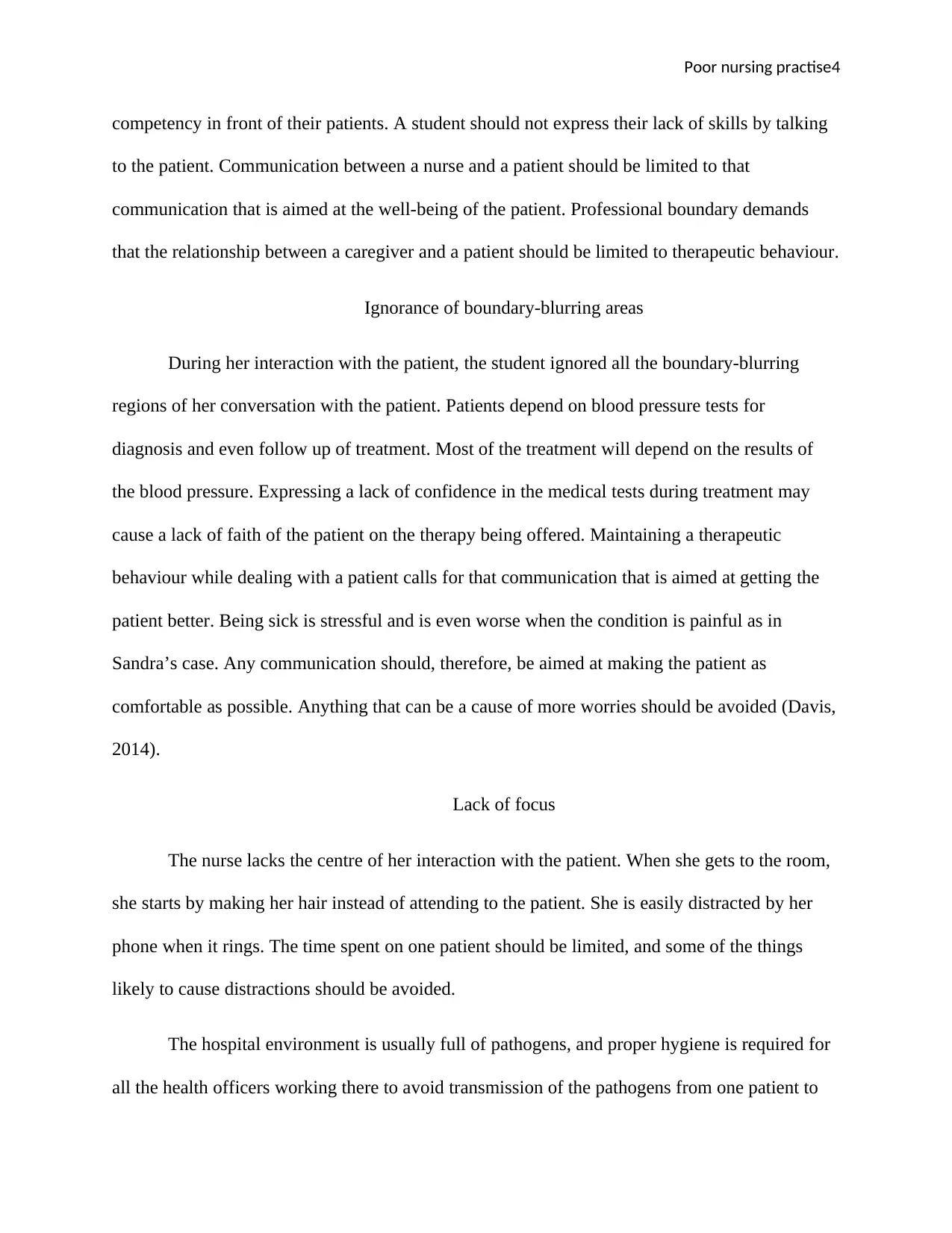
Poor nursing practise4
competency in front of their patients. A student should not express their lack of skills by talking
to the patient. Communication between a nurse and a patient should be limited to that
communication that is aimed at the well-being of the patient. Professional boundary demands
that the relationship between a caregiver and a patient should be limited to therapeutic behaviour.
Ignorance of boundary-blurring areas
During her interaction with the patient, the student ignored all the boundary-blurring
regions of her conversation with the patient. Patients depend on blood pressure tests for
diagnosis and even follow up of treatment. Most of the treatment will depend on the results of
the blood pressure. Expressing a lack of confidence in the medical tests during treatment may
cause a lack of faith of the patient on the therapy being offered. Maintaining a therapeutic
behaviour while dealing with a patient calls for that communication that is aimed at getting the
patient better. Being sick is stressful and is even worse when the condition is painful as in
Sandra’s case. Any communication should, therefore, be aimed at making the patient as
comfortable as possible. Anything that can be a cause of more worries should be avoided (Davis,
2014).
Lack of focus
The nurse lacks the centre of her interaction with the patient. When she gets to the room,
she starts by making her hair instead of attending to the patient. She is easily distracted by her
phone when it rings. The time spent on one patient should be limited, and some of the things
likely to cause distractions should be avoided.
The hospital environment is usually full of pathogens, and proper hygiene is required for
all the health officers working there to avoid transmission of the pathogens from one patient to
competency in front of their patients. A student should not express their lack of skills by talking
to the patient. Communication between a nurse and a patient should be limited to that
communication that is aimed at the well-being of the patient. Professional boundary demands
that the relationship between a caregiver and a patient should be limited to therapeutic behaviour.
Ignorance of boundary-blurring areas
During her interaction with the patient, the student ignored all the boundary-blurring
regions of her conversation with the patient. Patients depend on blood pressure tests for
diagnosis and even follow up of treatment. Most of the treatment will depend on the results of
the blood pressure. Expressing a lack of confidence in the medical tests during treatment may
cause a lack of faith of the patient on the therapy being offered. Maintaining a therapeutic
behaviour while dealing with a patient calls for that communication that is aimed at getting the
patient better. Being sick is stressful and is even worse when the condition is painful as in
Sandra’s case. Any communication should, therefore, be aimed at making the patient as
comfortable as possible. Anything that can be a cause of more worries should be avoided (Davis,
2014).
Lack of focus
The nurse lacks the centre of her interaction with the patient. When she gets to the room,
she starts by making her hair instead of attending to the patient. She is easily distracted by her
phone when it rings. The time spent on one patient should be limited, and some of the things
likely to cause distractions should be avoided.
The hospital environment is usually full of pathogens, and proper hygiene is required for
all the health officers working there to avoid transmission of the pathogens from one patient to
Paraphrase This Document
Need a fresh take? Get an instant paraphrase of this document with our AI Paraphraser
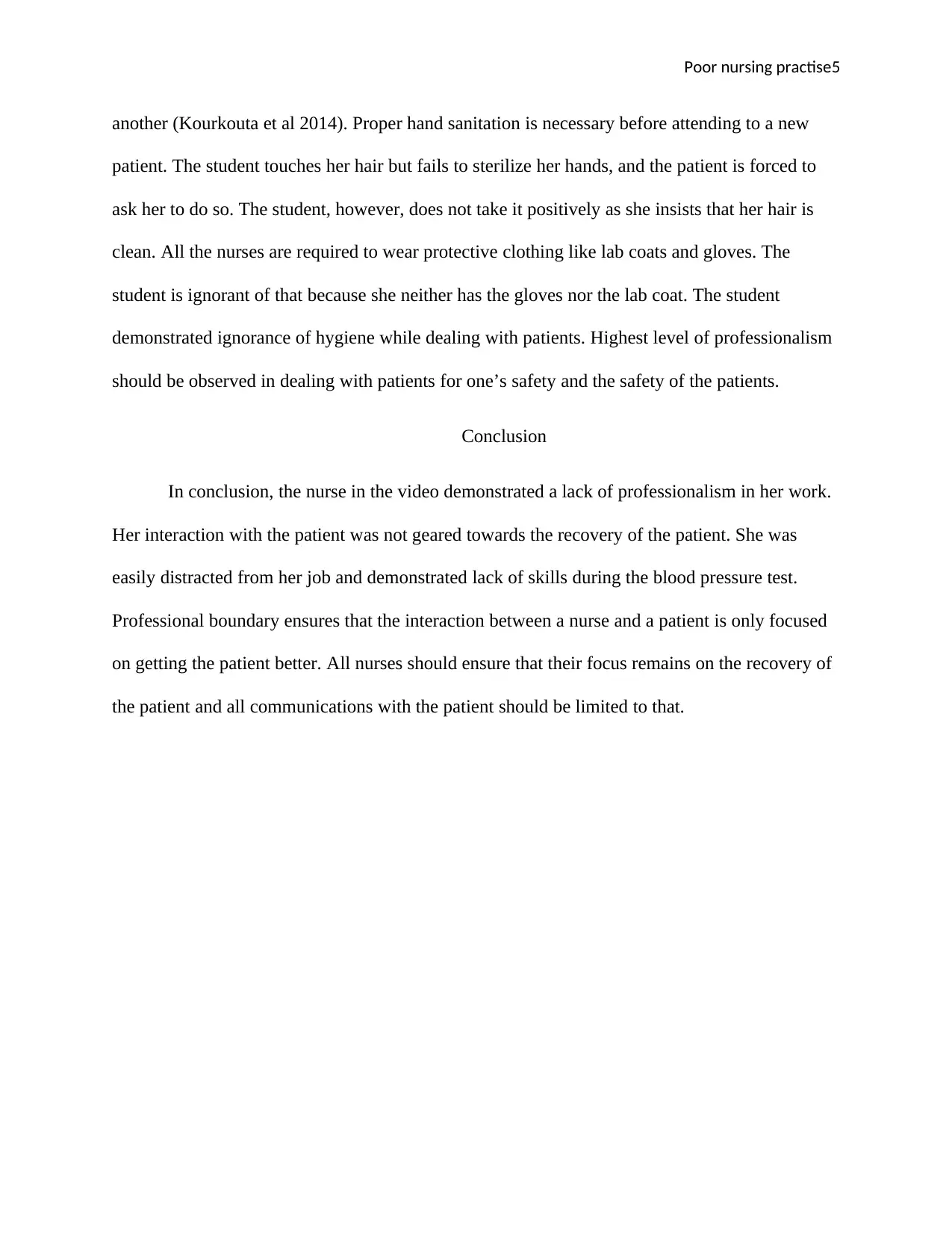
Poor nursing practise5
another (Kourkouta et al 2014). Proper hand sanitation is necessary before attending to a new
patient. The student touches her hair but fails to sterilize her hands, and the patient is forced to
ask her to do so. The student, however, does not take it positively as she insists that her hair is
clean. All the nurses are required to wear protective clothing like lab coats and gloves. The
student is ignorant of that because she neither has the gloves nor the lab coat. The student
demonstrated ignorance of hygiene while dealing with patients. Highest level of professionalism
should be observed in dealing with patients for one’s safety and the safety of the patients.
Conclusion
In conclusion, the nurse in the video demonstrated a lack of professionalism in her work.
Her interaction with the patient was not geared towards the recovery of the patient. She was
easily distracted from her job and demonstrated lack of skills during the blood pressure test.
Professional boundary ensures that the interaction between a nurse and a patient is only focused
on getting the patient better. All nurses should ensure that their focus remains on the recovery of
the patient and all communications with the patient should be limited to that.
another (Kourkouta et al 2014). Proper hand sanitation is necessary before attending to a new
patient. The student touches her hair but fails to sterilize her hands, and the patient is forced to
ask her to do so. The student, however, does not take it positively as she insists that her hair is
clean. All the nurses are required to wear protective clothing like lab coats and gloves. The
student is ignorant of that because she neither has the gloves nor the lab coat. The student
demonstrated ignorance of hygiene while dealing with patients. Highest level of professionalism
should be observed in dealing with patients for one’s safety and the safety of the patients.
Conclusion
In conclusion, the nurse in the video demonstrated a lack of professionalism in her work.
Her interaction with the patient was not geared towards the recovery of the patient. She was
easily distracted from her job and demonstrated lack of skills during the blood pressure test.
Professional boundary ensures that the interaction between a nurse and a patient is only focused
on getting the patient better. All nurses should ensure that their focus remains on the recovery of
the patient and all communications with the patient should be limited to that.
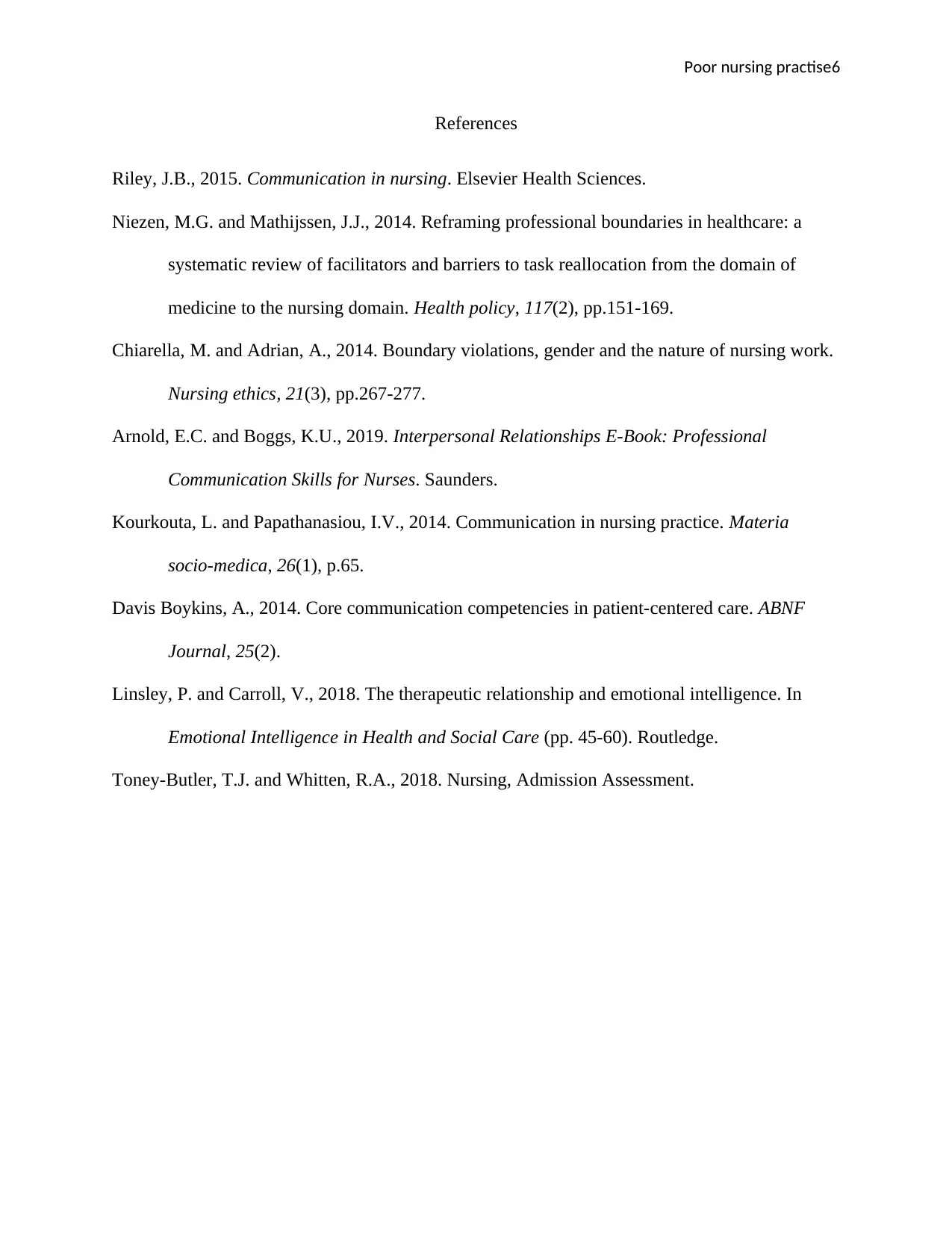
Poor nursing practise6
References
Riley, J.B., 2015. Communication in nursing. Elsevier Health Sciences.
Niezen, M.G. and Mathijssen, J.J., 2014. Reframing professional boundaries in healthcare: a
systematic review of facilitators and barriers to task reallocation from the domain of
medicine to the nursing domain. Health policy, 117(2), pp.151-169.
Chiarella, M. and Adrian, A., 2014. Boundary violations, gender and the nature of nursing work.
Nursing ethics, 21(3), pp.267-277.
Arnold, E.C. and Boggs, K.U., 2019. Interpersonal Relationships E-Book: Professional
Communication Skills for Nurses. Saunders.
Kourkouta, L. and Papathanasiou, I.V., 2014. Communication in nursing practice. Materia
socio-medica, 26(1), p.65.
Davis Boykins, A., 2014. Core communication competencies in patient-centered care. ABNF
Journal, 25(2).
Linsley, P. and Carroll, V., 2018. The therapeutic relationship and emotional intelligence. In
Emotional Intelligence in Health and Social Care (pp. 45-60). Routledge.
Toney-Butler, T.J. and Whitten, R.A., 2018. Nursing, Admission Assessment.
References
Riley, J.B., 2015. Communication in nursing. Elsevier Health Sciences.
Niezen, M.G. and Mathijssen, J.J., 2014. Reframing professional boundaries in healthcare: a
systematic review of facilitators and barriers to task reallocation from the domain of
medicine to the nursing domain. Health policy, 117(2), pp.151-169.
Chiarella, M. and Adrian, A., 2014. Boundary violations, gender and the nature of nursing work.
Nursing ethics, 21(3), pp.267-277.
Arnold, E.C. and Boggs, K.U., 2019. Interpersonal Relationships E-Book: Professional
Communication Skills for Nurses. Saunders.
Kourkouta, L. and Papathanasiou, I.V., 2014. Communication in nursing practice. Materia
socio-medica, 26(1), p.65.
Davis Boykins, A., 2014. Core communication competencies in patient-centered care. ABNF
Journal, 25(2).
Linsley, P. and Carroll, V., 2018. The therapeutic relationship and emotional intelligence. In
Emotional Intelligence in Health and Social Care (pp. 45-60). Routledge.
Toney-Butler, T.J. and Whitten, R.A., 2018. Nursing, Admission Assessment.
⊘ This is a preview!⊘
Do you want full access?
Subscribe today to unlock all pages.

Trusted by 1+ million students worldwide
1 out of 6
Related Documents
Your All-in-One AI-Powered Toolkit for Academic Success.
+13062052269
info@desklib.com
Available 24*7 on WhatsApp / Email
![[object Object]](/_next/static/media/star-bottom.7253800d.svg)
Unlock your academic potential
Copyright © 2020–2025 A2Z Services. All Rights Reserved. Developed and managed by ZUCOL.




